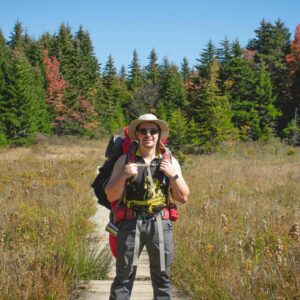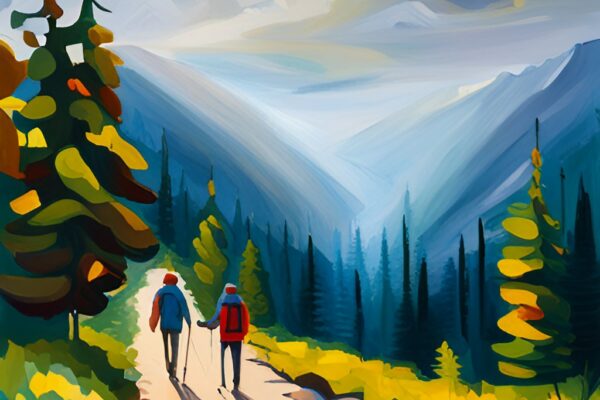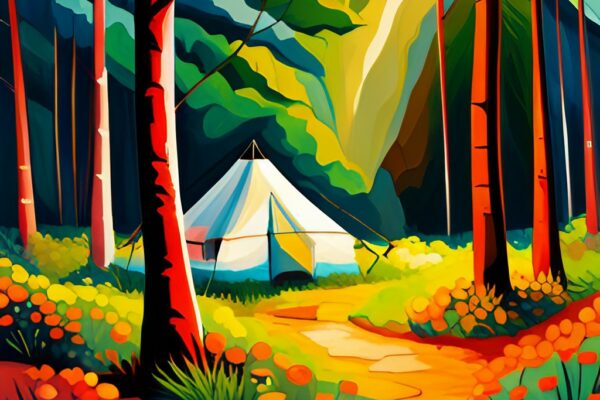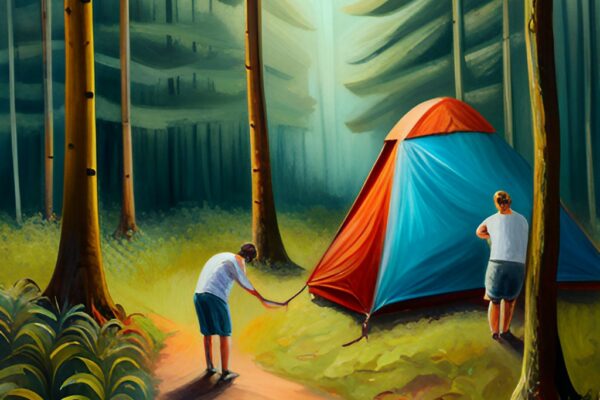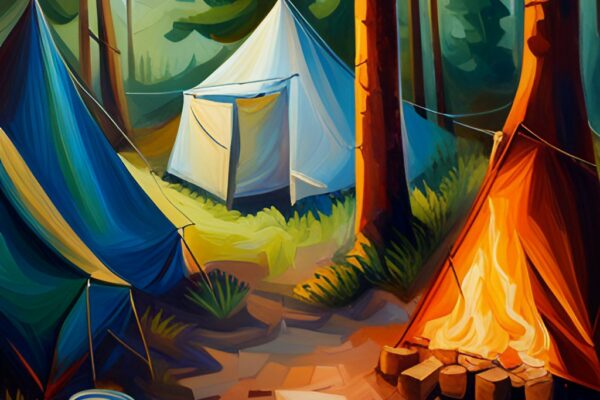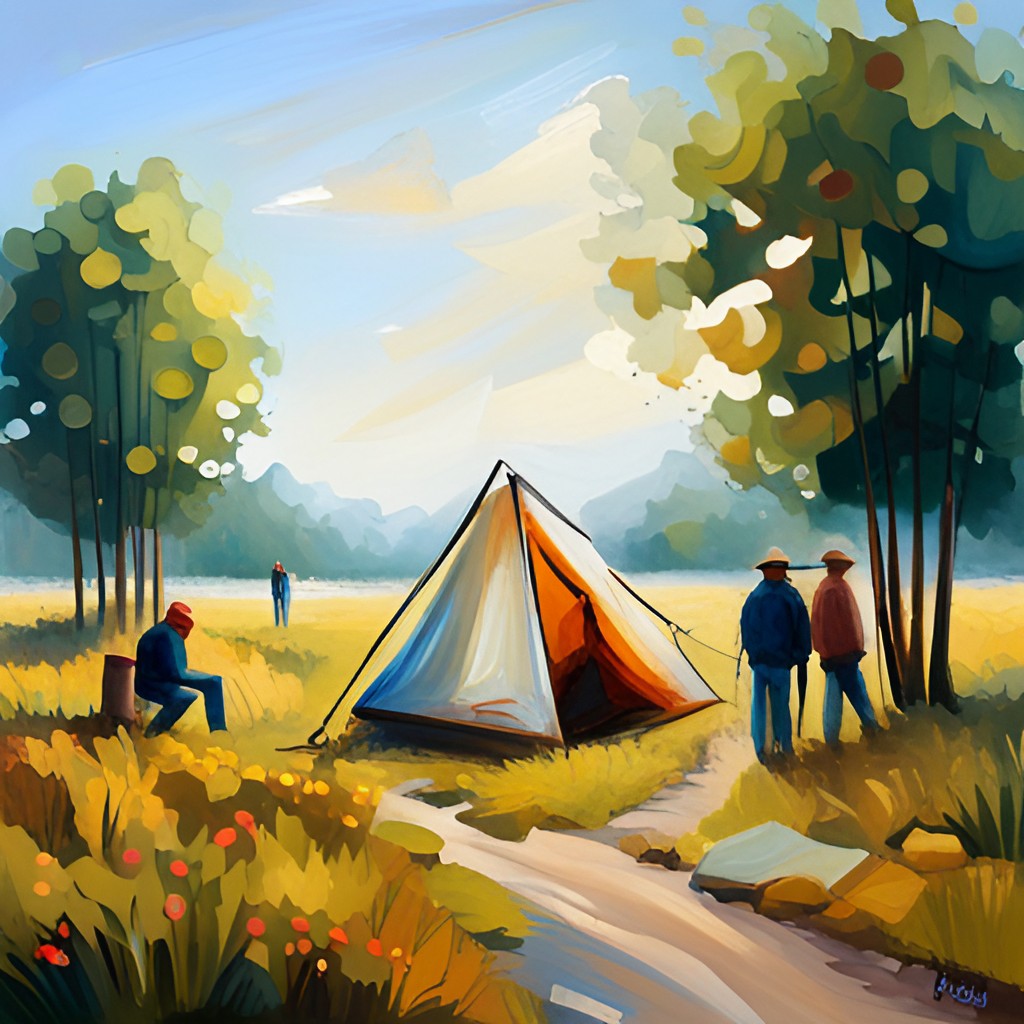
A well-planned camping setup is the foundation for a successful outdoor adventure. It sets the stage for comfort, convenience, and safety, fully immersing yourself in nature’s wonders.
This comprehensive guide will delve into the essentials of camping setup, offering expert advice and practical tips to help create a seamless and enjoyable outdoor experience. From selecting the perfect campsite to setting up your tent, organizing your gear, and embracing Leave No Trace principles, this article will equip you with the knowledge and skills needed to become a master of the art of camping setup.
So, confidently embark on your next camping journey as we unlock the secrets to a truly unforgettable outdoor excursion.
- Preparing for Your Adventure – Camping Setup 101
- A. Researching and Choosing the Perfect Campsite – Preparing for Your Adventure
- B. Essential Camping Gear and Equipment Checklist – Preparing for Your Adventure
- C. Packing Smart: Tips for Organizing and Streamlining your Supplies – Preparing for Your Adventure
- D. Safety First: Understanding and Mitigating Potential Hazards – Preparing for Your Adventure
- Setting Up Camp – Camping Setup 101
- Camp Kitchen Setup – Camping Setup 101
- Creating a Comfortable Campsite – Camping Setup 101
- A. Sleeping Systems: Choosing the Right Sleeping Bag and Pad – Creating a Comfortable Campsite
- B. Maximizing Comfort: Setting Up Camp Beds and Cots – Creating a Comfortable Campsite
- C. Creating a Cozy Ambiance: Lighting and Campfire Safety – Creating a Comfortable Campsite
- D. Hygiene and Sanitation: Tips for Maintaining Cleanliness in the Outdoors – Creating a Comfortable Campsite
- Organizing Your Outdoor Gear – Camping Setup 101
- Leave No Trace Principles – Camping Setup 101
- Campsite Teardown and Departure – Camping Setup 101
- A. Breaking Down Camp: Step-by-Step Guide – Campsite Teardown and Departure
- B. Leave No Trace Principles in Action: Cleaning Up and Restoring the Site – Campsite Teardown and Departure
- C. Proper Gear Storage and Post-Trip Maintenance – Campsite Teardown and Departure
- D. Reflecting on Your Camping Experience: Lessons Learned and Future Adventures – Campsite Teardown and Departure
- Conclusion – Camping Setup 101
Preparing for Your Adventure – Camping Setup 101
A. Researching and Choosing the Perfect Campsite – Preparing for Your Adventure
When planning your camping trip, thorough research is crucial for finding the perfect campsite that suits your preferences and needs. Consider location, accessibility, amenities, and nearby attractions or activities. Look for reliable sources of information like camping websites, park or forest service websites, and online reviews from fellow campers.
By taking the time to research and choose wisely, you can ensure a camping experience that aligns with your expectations.
B. Essential Camping Gear and Equipment Checklist – Preparing for Your Adventure
A well-prepared camper knows the significance of having the right gear and equipment for a successful trip. Create a checklist that includes camping essentials such as a tent, sleeping bag, camping stove, cooking utensils, lighting, first aid kit, and appropriate clothing.
Additionally, consider specific items based on the activities you plan to engage in, such as hiking gear, fishing equipment, or water sports gear. Remember to check that all equipment is in good condition and make necessary repairs or replacements before your trip.
C. Packing Smart: Tips for Organizing and Streamlining your Supplies – Preparing for Your Adventure
Efficient packing plays a vital role in optimizing your camping experience. Organize your supplies into categories and pack them in separate, labeled containers or bags to locate items when needed quickly. Utilize storage solutions like compression sacks, waterproof containers, and packing cubes to maximize space and protect your gear from the elements.
Prioritize lightweight and multi-functional items to minimize the overall weight of your backpack or vehicle load. Remember to pack essentials like food, water, and personal hygiene items, while being mindful of Leave No Trace principles.
D. Safety First: Understanding and Mitigating Potential Hazards – Preparing for Your Adventure
Ensuring your safety and the safety of your fellow campers should be a top priority. Familiarize yourself with potential hazards in the camping area, such as wildlife encounters, extreme weather conditions, and terrain challenges. Research and understand the proper protocols for handling encounters with wild animals, emergency preparedness, and basic first aid.
When necessary, carry appropriate safety equipment like fire extinguishers, insect repellents, and bear-resistant containers. Always inform someone about your camping plans, including expected return dates and emergency contacts, for added peace of mind.
Setting Up Camp – Camping Setup 101
A. Finding the Ideal Campsite Layout – Setting Up Camp
The layout of your campsite can significantly impact your overall camping experience. Look for level ground to ensure a comfortable sleep and a stable setup. Consider the proximity of natural features like trees for shade and windbreaks and access to water sources and facilities.
Plan the layout strategically, separating sleeping, cooking, and relaxation activities. Finding the ideal campsite layout can optimize functionality and create a harmonious outdoor living space.
B. Pitching Your Tent: Step-by-Step Instructions and Pro Tips – Setting Up Camp
Pitching a tent is a fundamental skill for any camper. Follow the manufacturer’s instructions carefully, starting with a clear and clean area. Stake out the tent corners, ensuring a taut pitch, and use guylines and tensioners to reinforce stability. Consider the prevailing wind direction and orient your tent accordingly.
Pro tip: Practice setting up your tent before your camping trip to familiarize yourself with the process and make necessary adjustments. It will save you time and frustration once you’re at the campsite.
C. Utilizing Tarps, Groundsheets, and Tent Footprints – Setting Up Camp
Use tarps, groundsheets, and tent footprints to enhance your camping setup’s durability and comfort. Place a groundsheet or tent footprint under your tent to protect against moisture and abrasion. Set up a tarp above your tent to create a dry area for cooking or relaxing during inclement weather. Secure the tarp with ropes and stakes to shield your campsite from rain or excessive sunlight.
These additional layers will help extend the lifespan of your equipment and improve your overall camping experience.
D. Setting Up Camp Furniture: Chairs, Tables, and Hammocks – Setting Up Camp
Transform your campsite into a cozy and functional haven by setting up camp furniture. Portable chairs and tables provide comfort and convenience for meals and relaxation. Look for lightweight and collapsible options to save space during transport. Hammocks offer a perfect spot for a lazy afternoon nap or enjoying the serenity of nature. Ensure proper tree selection and use tree straps to protect the bark.
Respect the environment and avoid damaging trees when setting up your hammock. These camp furniture additions will elevate your camping setup and make your outdoor experience more enjoyable.
Camp Kitchen Setup – Camping Setup 101
A. Selecting the Right Cooking Equipment – Camp Kitchen Setup
A well-equipped camp kitchen is essential for satisfying meals in the great outdoors. Choose cooking equipment that suits your camping style, whether a portable stove, a compact grill, or a traditional campfire setup.
Consider fuel efficiency, ease of use, and cleaning requirements. Invest in durable and lightweight cookware, including pots, pans, and utensils, that can withstand the rigors of outdoor cooking. Pack essentials like a cutting board, knife set, and heat-resistant gloves for safe food preparation.
B. Building and Maintaining a Safe Campfire – Camp Kitchen Setup
Building a campfire can be a highlight of any camping experience, but safety should always be the top priority. Select a designated fire pit or clear an area free from flammable materials. Follow local regulations and fire restrictions, and never leave a fire unattended. Gather firewood from the ground, not from live trees, and ensure it’s dry to promote efficient burning.
Always have a water source and a shovel nearby to control the fire and fully extinguish it before leaving. Familiarize yourself with proper fire-starting techniques and fire safety protocols for a worry-free campfire experience.
C. Efficient Food Storage and Meal Preparation Techniques – Camp Kitchen Setup
Proper food storage and meal preparation techniques are essential for a successful camp kitchen setup. Coolers with ice or ice packs keep perishable food items fresh and safe. Organize your food supplies to minimize the risk of cross-contamination and ensure easy access.
Prepping ingredients in advance and utilizing zip-lock bags or airtight containers can simplify meal preparation at the campsite. Opt for simple and versatile recipes that use minimal cookware and ingredients, making cleanup more accessible and allowing you to focus more on enjoying your time outdoors.
D. Essential Camp Cooking Hacks and Recipes – Camp Kitchen Setup
Elevate your camp cooking game with essential hacks and delicious recipes tailored for outdoor adventures. Learn time-saving tricks, such as pre-measuring ingredients and pre-cutting vegetables, to streamline meal preparation. Explore one-pot recipes that minimize cleanup and maximize flavor. Embrace the versatility of foil packet cooking for easy and delicious meals.
Remember to experiment with campfire desserts and creative snacks that add a touch of indulgence to your camping experience. Stay tuned for our upcoming articles, where we will dive deeper into camp cooking hacks and share mouthwatering recipes that will make your outdoor meals unforgettable.
Creating a Comfortable Campsite – Camping Setup 101
A. Sleeping Systems: Choosing the Right Sleeping Bag and Pad – Creating a Comfortable Campsite
A restful night’s sleep is crucial for an enjoyable camping experience. Selecting the right sleeping bag and pad is essential for comfort and insulation. Consider the expected weather conditions and temperature ratings when choosing a sleeping bag. Opt for a pad or mattress that provides adequate cushioning and insulation from the cold ground.
If camping with a partner, ensure your sleeping systems are compatible for a cozy and uninterrupted night’s sleep. Prioritize quality and durability when investing in sleeping gear, as it can significantly impact your overall camping comfort.
B. Maximizing Comfort: Setting Up Camp Beds and Cots – Creating a Comfortable Campsite
Camp beds and cots can provide a fantastic solution if you desire an elevated level of comfort. These portable sleeping platforms raise you off the ground, providing additional support and insulation. Look for lightweight, collapsible, easy transport and set up options.
Consider weight capacity, stability, and durability when choosing a camp bed or cot. Pair them with a comfortable sleeping pad or mattress for ultimate relaxation during camping nights.
C. Creating a Cozy Ambiance: Lighting and Campfire Safety – Creating a Comfortable Campsite
Lighting is crucial in creating a cozy and inviting ambiance at your campsite. Utilize a combination of sources such as lanterns, headlamps, and string lights to provide ample illumination for activities and navigation after dark. Prioritize safety by ensuring all lighting equipment is in good working condition and use caution when operating open flames.
Remember to follow proper campfire safety protocols and use designated fire rings or pits. Enjoy the warm glow of a campfire while taking necessary precautions to prevent accidents and protect the surrounding environment.
D. Hygiene and Sanitation: Tips for Maintaining Cleanliness in the Outdoors – Creating a Comfortable Campsite
Proper hygiene and sanitation ensure a comfortable and healthy camping experience. Pack biodegradable soap, hand sanitizer, and toiletries to maintain cleanliness. Choose a suitable location away from water sources for bathroom needs, and always follow Leave No Trace principles.
Properly dispose of waste in designated receptacles or pack it out to minimize your environmental impact. Carry a small shovel for burying human waste and secure trash to prevent attracting wildlife. Practicing good hygiene and sanitation contributes to a positive camping experience for yourself and others.
Organizing Your Outdoor Gear – Camping Setup 101
A. Gear Storage Solutions and Organization Tips – Organizing Your Outdoor Gear
Organizing and storing your outdoor gear can save you time and frustration when setting up and packing for your camping trips. Invest in gear storage solutions such as duffel bags, backpack organizers, and storage bins to keep your equipment neatly organized and protected from damage. Utilize labels or color-coded systems to identify different gear categories quickly.
Create a designated gear storage area at home to sort and maintain your equipment between trips. You’ll have quick access to your gear and ensure its longevity by implementing effective storage solutions and organization techniques.
B. Backpacking Essentials: Efficient Packing Techniques – Organizing Your Outdoor Gear
Backpacking requires strategic packing to optimize weight distribution and maximize space. Prioritize essential items like your tent, sleeping bag, and cooking equipment. Utilize compression sacks or packing cubes to minimize the size of your clothing and gear.
Pack heavier items closer to your back and distribute weight evenly to maintain balance. Keep frequently used items readily accessible, such as water bottles, snacks, and navigation tools. Regularly assess your gear list and eliminate non-essential items to minimize pack weight.
You can enjoy a comfortable and hassle-free backpacking adventure by mastering efficient packing techniques.
C. Gear Maintenance and Repair: Extending the Lifespan of Your Equipment – Organizing Your Outdoor Gear
Proper gear maintenance and repair practices are vital for extending the lifespan of your outdoor equipment. Regularly clean and dry your gear after each trip to prevent mold, mildew, and deterioration. Inspect your gear for signs of wear and tear, such as frayed seams or broken zippers, and address repairs promptly. Learn basic repair techniques or seek professional assistance when necessary.
Treat your gear with waterproofing solutions to enhance its durability and performance in wet conditions. Caring for and maintaining your equipment will save money in the long run and ensure its reliability and functionality when needed.
Leave No Trace Principles – Camping Setup 101
A. Understanding the Importance of Leave No Trace Camping – Leave No Trace Principles
Leave No Trace principles are ethical guidelines that promote responsible outdoor behavior and minimize the impact of human activities on natural environments. By practicing Leave No Trace camping, you contribute to preserving and sustaining our natural spaces for future generations.
Understanding the importance of Leave No Trace principles helps foster a deep respect for the environment and encourages mindful decision-making while enjoying the outdoors.
B. Minimizing Environmental Impact: Waste Disposal and Recycling – Leave No Trace Principles
One of the core principles of Leave No Trace camping is minimizing our environmental impact. Proper waste disposal and recycling are essential aspects of this principle. Pack out all trash, including food waste, and leave no trace of your presence.
Use designated waste receptacles or pack out your waste if no disposal facilities are available. Practice Leave No Trace ethics by adhering to the “pack it in, pack it out” philosophy, ensuring the natural environment remains pristine and pollution-free.
C. Respectful Wildlife Encounters and Responsible Outdoor Ethics – Leave No Trace Principles
When engaging with wildlife during your camping trips, it’s crucial to maintain respectful and responsible behavior. Observe wildlife from a distance to minimize disturbance and avoid altering their natural behavior. Do not feed or approach animals, leading to habituation and dangerous situations for humans and wildlife.
Before your trip, learn about the local flora and fauna to understand their ecological significance and the best practices for interacting with them. By adopting responsible outdoor ethics, you contribute to the well-being and conservation of wildlife populations and their habitats.
Campsite Teardown and Departure – Camping Setup 101
A. Breaking Down Camp: Step-by-Step Guide – Campsite Teardown and Departure
As your camping trip ends, knowing how to efficiently and effectively break down your campsite is essential. Follow a step-by-step guide that includes tasks such as dismantling your tent, packing your gear, and removing any tarps or temporary structures.
Properly store items in their designated places to ensure easy access and organization for future trips. By systematically breaking down camp, you’ll save time and leave the site in a better condition.
B. Leave No Trace Principles in Action: Cleaning Up and Restoring the Site – Campsite Teardown and Departure
Just as you arrived at a pristine campsite, leaving it in the same condition or even better is crucial. Embrace the Leave No Trace principles and clean up any trash or debris left behind. Collect and dispose of waste properly, ensuring it is packed or placed in designated receptacles.
Restore the natural environment by removing signs of your presence, such as fire rings or disturbed vegetation. Pay attention to details and leave the campsite as if you were never there, minimizing your impact on the ecosystem.
C. Proper Gear Storage and Post-Trip Maintenance – Campsite Teardown and Departure
After returning from your camping trip, storing and maintaining your gear is essential. Clean and dry equipment thoroughly to prevent mold, mildew, or corrosion. Inspect gear for any damage or wear and address repairs promptly. Follow the manufacturer’s instructions for long-term storage to extend the lifespan of your equipment.
Take this opportunity to replenish consumable items and restock your supplies to prepare for your next adventure. Proper gear storage and maintenance ensure your equipment stays in optimal condition and is always ready for your next camping escapade.
D. Reflecting on Your Camping Experience: Lessons Learned and Future Adventures – Campsite Teardown and Departure
Take the time to reflect on your camping experience and the lessons learned. Evaluate what worked well and what you could improve for future trips. Consider the challenges you faced and how you overcame them.
Reflect on the moments of joy and connection with nature. Use these insights to enhance your future camping adventures and make the necessary adjustments to improve your setup, packing, or camping routines. Embrace the memories created during your camping trip and let them fuel your enthusiasm for future outdoor explorations.
As you embark on the teardown and departure process, remember to follow a step-by-step guide for breaking down camp, put the Leave No Trace principles into action by cleaning up and restoring the campsite, take care of your gear through proper storage and post-trip maintenance, and reflect on your camping experience to continuously enhance your future adventures.
Conclusion – Camping Setup 101
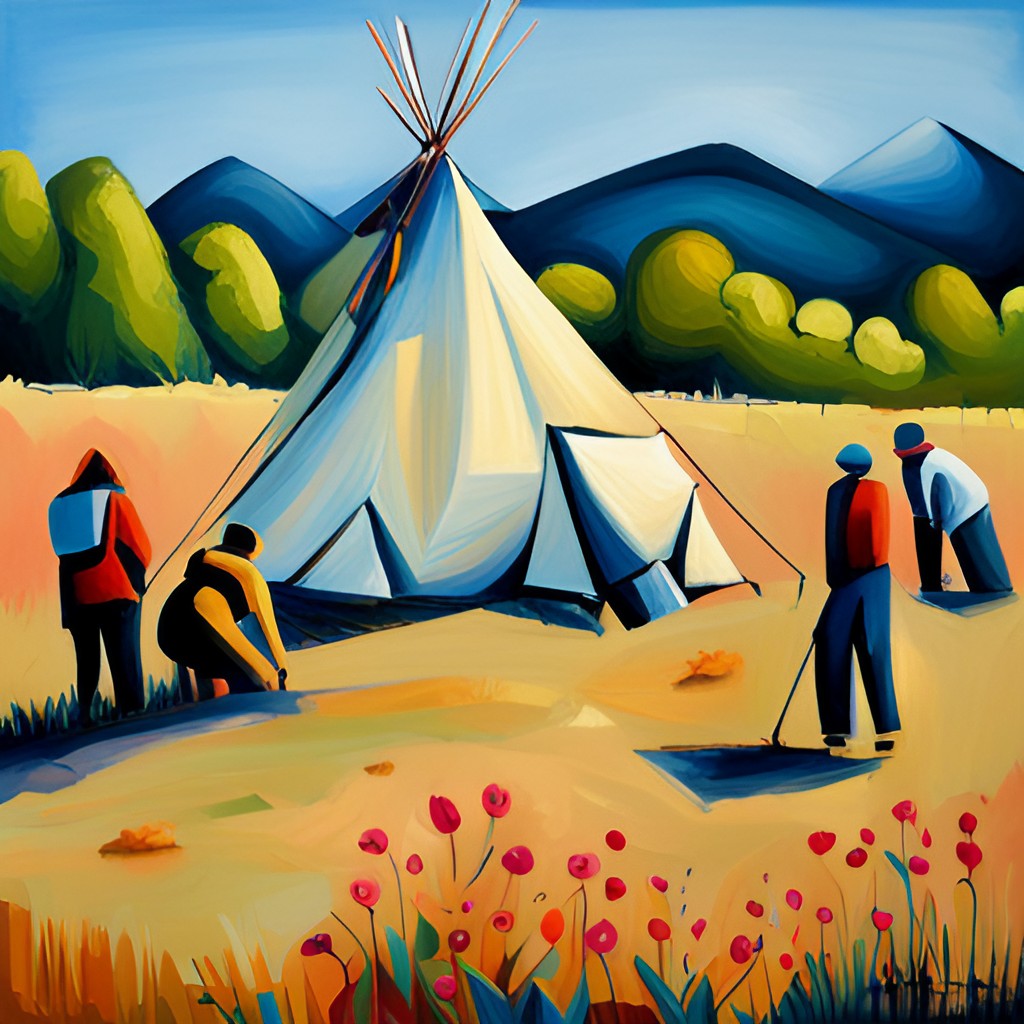
In conclusion, mastering the art of camping setup is an ongoing journey that brings us closer to nature and ourselves. By following the principles and tips outlined in this ultimate guide, we can create a seamless outdoor experience that is both enjoyable and sustainable.
Embrace the joy camping brings, from the tranquility of starlit nights to the sense of adventure in exploring new landscapes. Share your experiences and learn from fellow campers, as the camping community is a wealth of knowledge and inspiration.
Let’s empower one another to connect with nature, leave no trace, and embark on unforgettable camping adventures. Happy camping!
Recommended Reading – Conclusion
Internal:
The Best Tent Accessories To Enhance Your Camping Experience – Tent Camping Trips
Mastering The Great Outdoors: Essential Camping Tips For Beginners (tentcampingtrips.com)
External:
The Best Family Tent Camping Setup And Camping Essentials Breakdown (settocamp.com)
Mastering the Art of Camping: Your Ultimate Guide | OutdoorZine

